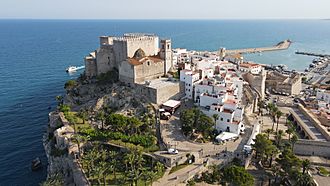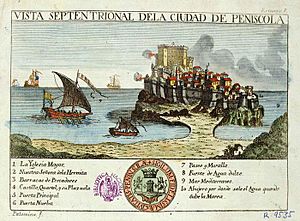Peniscola Castle facts for kids
Quick facts for kids Peniscola Castle |
|
|---|---|
|
Valencian: Castell de Peníscola
|
|

The castle and town walls, aerial view
|
|
| General information | |
| Location | Peniscola, province of Castellón |
| Country | Spain |
| Coordinates | 40°21′32″N 00°24′29″E / 40.35889°N 0.40806°E |
| Elevation | 64 metres (210 ft) |
| Completed | 1307 |
The Peniscola Castle (also known as Castillo de Peñíscola or Castell de Peníscola) is a famous castle in Peniscola, Spain. It stands on a rocky cliff, high above the Mediterranean Sea. The castle is about 64 meters (210 feet) above sea level.
This amazing castle has been carefully restored. Today, it is open for everyone to visit and explore. It's a popular spot for tourists and families.
Contents
History of Peniscola Castle
People have lived in the Peñíscola area for a very long time. We know this from old Ibero-Roman remains found there. These remains are from around 100 to 200 years before Christ.
In the 11th century, an Arab writer named Al-Idrisi wrote about a "Moorish" (Muslim) castle. This early castle also looked out over the sea. Later, in the 13th century, King James I of Aragon took control of the area. This happened in 1229.
The Knights Templar Build the Castle
The castle you see today was mostly built by the Knights Templar. They were a powerful group of warrior monks. In 1294, King James II of Aragon gave the castle to them. They also received nearby castles like Pulpís and Xivert.
The Knights Templar started building right away. They tore down the old Muslim walls. Then, they built a completely new castle. The work was finished in 1307. Like other Templar castles, it had a central courtyard and a chapel. It featured strong, rounded arches and vaulted ceilings.
A Pope's Home
The main part of the Templar castle is still there. But some changes were made in the early 15th century. This was when Antipope Benedict XIII lived there. He was a leader of the Catholic Church during a time when there were two popes. He made the castle his home from 1417 until he died in 1423.
Castle Defenses and Conflicts
From the 16th century onwards, the castle's defenses were made much stronger. This was because military technology was improving. A famous military engineer named Giovanni Battista Antonelli worked on the castle in the 16th century.
The castle was part of many battles over the years. It was involved in conflicts during the Kingdom of Aragon. Later, it saw action in the War of the Spanish Succession in the early 1700s. It was also part of the Peninsula War and other civil conflicts in the early 1800s. Each battle changed the castle's defenses in some way. The soldiers guarding the castle finally left in 1890.
Peniscola Castle Today
In 1960, the castle was restored and improved again. New walls were added. This was partly because the movie El Cid was filmed there. The town and castle of Peñíscola were used to represent the city of Valencia in the film.
Today, Peniscola Castle is a very popular place to visit. The nearby beaches and area are also a favorite spot for family holidays.
See also
 In Spanish: Castillo Palacio de Peñíscola para niños
In Spanish: Castillo Palacio de Peñíscola para niños


